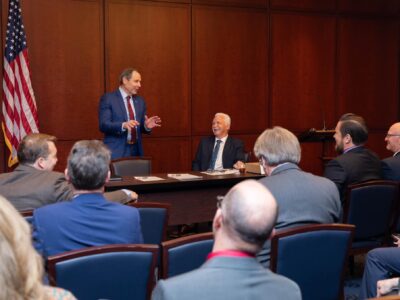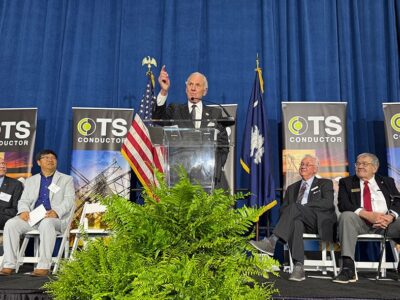The state of the American railway is a hot topic among climate scientists and transportation experts. The United States used to have the first transcontinental rail system, but that’s a distant memory — a very distant memory.
Today, Amtrak is the only interstate railroad. When people complain about the country’s car dependence, they focus on areas like the Midwest, the South, Texas, and California.
It’s universally acknowledged that modern railways are one of the best ways to reduce transportation emissions. Europe and Asia have several reliable, interconnected railroads, and some countries like Japan and China have high-speed, zero-emission trains. How can the U.S. find a way to create a more efficient transcontinental railroad like it had in the past?
Rinaldo Brucoto, founder and president of World Business Academy, spoke with The Business Download to explain why the American rail system lags behind Europe, Japan, and China and what the country can do about it.
“Why on Earth are we so behind everybody else in the world? Because we’ve been standing still since 1850,” he explained.
“We have a very entrenched monopoly; it’s kind of a shared oligopoly in the automobile manufacturers, which is only starting to get broken up now with electric vehicles, where you finally have competition in the marketplace. There’s still a tremendous lobby that supports fossil fuels.”

Photo Courtesy James Lewis
With any change — new technology or method of transportation — there is pushback. In this case, it hasn’t been just the auto industry. Some airlines have advocated against trains as well. The New York Times reported that Southwest Airlines is believed to have thwarted an attempt to build a high-speed rail system in Texas, a major car-reliant state. This pushback also plays a role in the continued use of the interstate highway system and why electric vehicles (EVs) are considered the best way for Americans to decarbonize personal transportation.
California, another car-heavy state where Brucoto resides, will end gas-powered car sales and strictly sell zero-emission vehicles (ZEVs) by 2035. However, the state has a unique history with public transportation.
“In California, as you will recall, we had one of the finest metropolitan transit systems in the world, called the red car — a streetcar that ran all over Los Angeles and was efficient, effective, well-loved, and well-ridden,” Brutoco said. “It was destroyed by an unlawful combination of oil, Firestone Tire, and General Motors. And it took them 15 years to get caught. And the fine was about $5,000 as I recall, and what they stole over all those years was in the hundreds of billions. The transportation system had been destroyed. And as a result, L.A. became the car capital of the world.” He mentioned the monopoly was worth around $50 billion in today’s money.
The East Coast has been the best example of a European-style train system. Amtrak’s Northeast Corridor is the most-ridden route, connecting Washington, D.C., New York City, and Boston. Brutoco said due to its effectiveness, he has never needed to take a plane from Washington to New York City.
Further, New York City and Washington connect to commuter railways from the MTA, MARC, VRE, NJ Transit, PATH, LIRR, Metro-North, the New York Subway system, and the D.C. Metro. In fact, Amtrak has shuttled politicians to and from D.C. to their homes, including the current president when he was a senator from Delaware — a two-hour ride from the First State to the capital.

Photo Courtesy Richard Lu
“What happened was they found that they make money on Amtrak. They’ve been making money on Amtrak for decades,” Brutoco said. “That’s the kiss of death because that means they don’t want to expand it. Let me tie that to the example you asked about California.”
“In California, you have one — two originally — railroads that control all the rights to us, which, given those rights away, were granted as an accommodation to carry passengers,” he continued. “Well, I can drive my car from Santa Barbara to San Francisco faster than I can take the train.”
“When you have a state as long as California, you should have a hub on the border in San Diego. It should go all the way up the Pacific coast of the existing [U.S Route] 101 and shouldn’t go through inland where there aren’t as many people,” Brutoco said.
“And you could take that exact line up to Seattle if you want. That line would be economic immediately. Because there’s so much plane traffic on that route.”
Brutoco claimed adding a second track and upgrading it to account for Amtrak speeds would replace at least 60% of air traffic between L.A. and San Francisco. It would be more environmentally friendly and would take less time than driving.

Photo Courtesy Eddie Bugajewski
The renewable energy boom and the emphasis on EVs are helping to drive the decarbonization of the rail system. California is mandating that by 2030, only trains less than 23 years old operate in the state. The state is also requiring that in 2030, all new passenger trains built must have zero emissions, with freight lines following in 2035, phasing out diesel. Brutoco explained that this law would create nearly $32 billion in public health and economic advantages.
Brutoco also highlighted Canadian railroads between Calgary and Edmonton, Alberta, using grey hydrogen as fuel.
He also discussed an example from the Swiss rail company Stadler, which set a hydrogen train distance record in Colorado this past March.
Hydrogen energy could be the saving grace for the zero-emission American rail system, but Brutoco believes the fuel price and infrastructure are major setbacks. He noted that Air Products and Air Liquide controlled most of California’s hydrogen fuel development, and without competition, prices have risen. It went from $9 a kilogram to $36 per kilogram when synthesized.
As the prices increased, interest in hydrogen waned. Brutoco owns a hydrogen fuel-cell vehicle and says the cost of hydrogen has made his car worthless. He can’t even trade it in for parts.
However, he believes the rail system can support the hydrogen-based decarbonization efforts. Brutoco shared a video of a Caltrans initiative to use small-diameter pipes to distribute hydrogen across freeways and highways. Trucks could run on hydrogen and refuel along this system, which would reduce the price of hydrogen back to around $8.
Video Courtesy H2C
Locomotives are switching to hydrogen and could use a similar system to refuel along tracks. This is promising because many trains can not be electrified.
“The inner city is always going to be problematic because you can’t electrify every line in every metropolitan area. It’s just not possible and wouldn’t be reasonable,” Brutoco explained why there isn’t more electrified rail. “But you can electrify the line between Paris and London.”
He used the English Channel Chunnel as an example of electric rail effectiveness. Short-distance trains would benefit from zero-emission power. Plans for a low-emission, high-speed railway in California have lost support over time.
“I don’t see a lot of future for high-speed rail government,” Brutoco opined.
“On the other hand, I see a phenomenal future for hydrogen agents on a straighter track running between San Diego and at least Sacramento, swinging up in San Francisco. At the very least.”

Photo Courtesy Stephen Mease
America could emulate several practices of European and Asian rail systems, like connecting state tracks and integrating more Light Rail and subways. The Northeast Corridor from Boston to Washington is great, but anything south of D.C. is tougher to ride.
Chicago to St. Louis is also a popular destination for Midwestern Amtrak, but it is underutilized due to travel times. The Mountain West doesn’t have large train hubs, despite the Old West being the pinnacle of the early modern railway.
Although Amtrak has promised more zero-emission trains and received federal funding for Northeast Corridor improvements, more work is needed in the rest of the country. More trains can lead to fewer cars on the road, bringing America closer to achieving its carbon neutrality goals.





